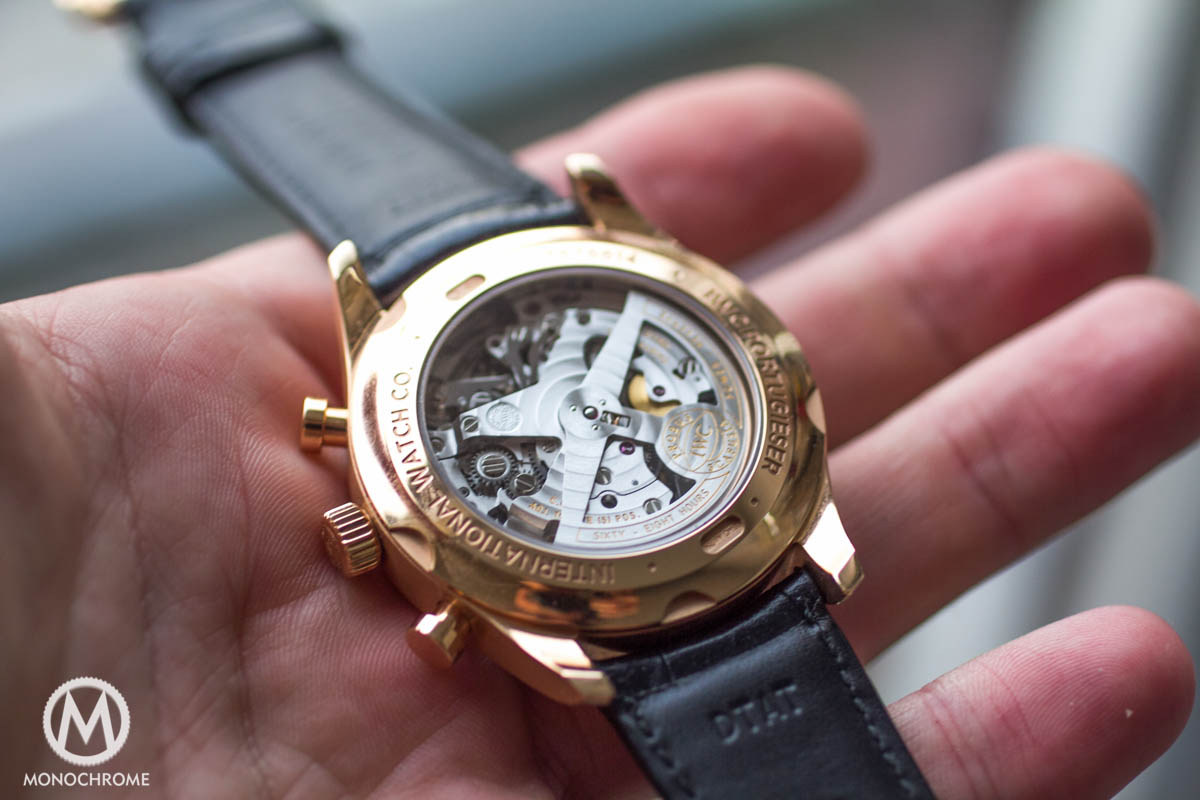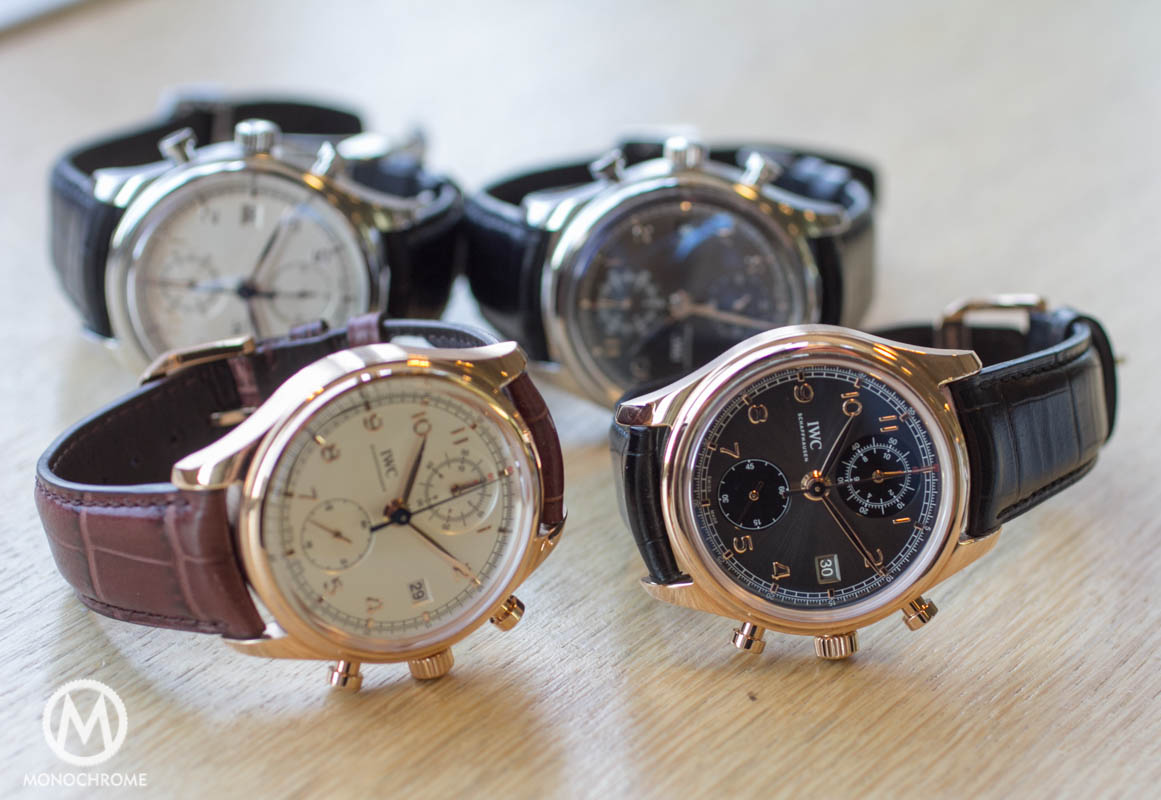REVIEW: IWC Portuguese Chronograph Classic ref. 3904

Last year IWC introduced not only an entirely renewed Ingenieur collection, at the annual Salon International de la Haute Horlogerie. Later in the year they (more or less) quietly introduced two new models in the Portuguese collection: the Portuguese Hand-Wound 8-Days and the IWC Portuguese Chronograph Classic. Today we’re going to have a close look at the Portuguese Chronograph Classic in pink gold.
Although these two were not presented during the SIHH as the big novelty, we think that this is at least as ‘big’ as the entire new Ingenieur family. Here’s why… “the other” Portuguese Chronograph -reference 3714- is one of IWC’s most successful watches ever, and has been in the collection since 1998. That is sixteen years. And the Portuguese Rattrapante, with the same looks however with the ‘doppelchrono’ movement, was introduced into the IWC collection two years earlier in 1996. So besides the usual review questions -how does it wear, is it easy to read the time from, how does it perform- there’s also the question how the new IWC Portuguese Chronograph Classic holds up against its older brother that actually has become a “classic” in these past sixteen years.
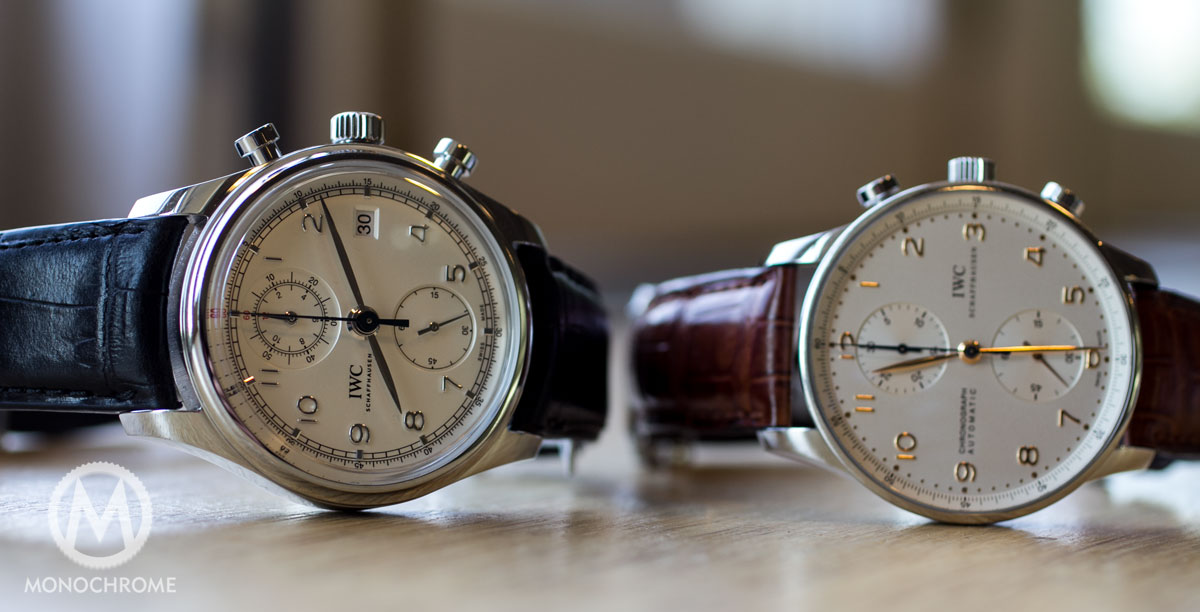
A Brief History of IWC
The International Watch Company was not founded by a Swiss watchmaker, but by an American engineer and watchmaker from Boston. Florentine Ariosto Jones, or short F.A. Jones, founded the company in 1868 and a year later he rented the first factory premises in an industrial building owned by J.H. Moser (yes, that’s the founder of what now is H. Moser & Cie.) Five years later, in 1874, Jones buys a site from Moser’s hydro-electric company, which also supplied (cheap) power for the factory. In 1875 the construction work was completed and 196 people started working there.
Jones chose the town of Schaffhausen for several reasons. First was that in the French speaking part of Switzerland, people feared to lose their jobs, since Jones intended to combine Swiss craftsmanship with modern engineering technology from the U.S. to manufacture movements and watch parts for the American market. Schaffhausen proved to be perfect, because J.H. Moser built Schaffhausen’s first hydroelectric plant and with that he laid the cornerstone for future industrialization.
For a full description of IWC’s history, please visit the IWC website here, or IWC’s page on Wikipedia here.
The Portuguese collection
In another review we’ll focus more on the genesis of the Portuguese collection. More relevant in this context is that the first Portuguese Chronograph was actually the Portuguese Rattrapante, with the split seconds chronograph that was developed by Richard Habring (among others). Two years later IWC introduces the ref. 3714 which is the Portuguese Chronograph that has been in the collection for the past sixteen years.

Today’s Portuguese collection comprises 12 reference numbers, not counting the special/limited editions. The collection varies from a simple hand-wound Portuguese, to a Minute Repeater, a Perpetual Calendar, a Grande Complication and the Portuguese Sidérale Scafusia. The most iconic models are probably the Portuguese Perpetual Calendar (ref. 5032), the Portuguese Automatic (ref. 5001), the Portuguese Minute Repeater (ref. 5449) and the Portuguese Chronograph (ref. 3714). And now we wonder, how the new IWC Portuguese Chronograph Classic holds up among so much horological history and icons.
Overall appearance of the IWC Portuguese Chronograph Classic
When compared to its ‘predecessor’, the new ref. 3904 looks like an entirely different watch. So for the sake of this review, we’ll do our best to forget about one of our favorite watches from Schaffhausen, and focus entirely on the new one. However at the end of this review, we’ll make a short comparison of some specifications.
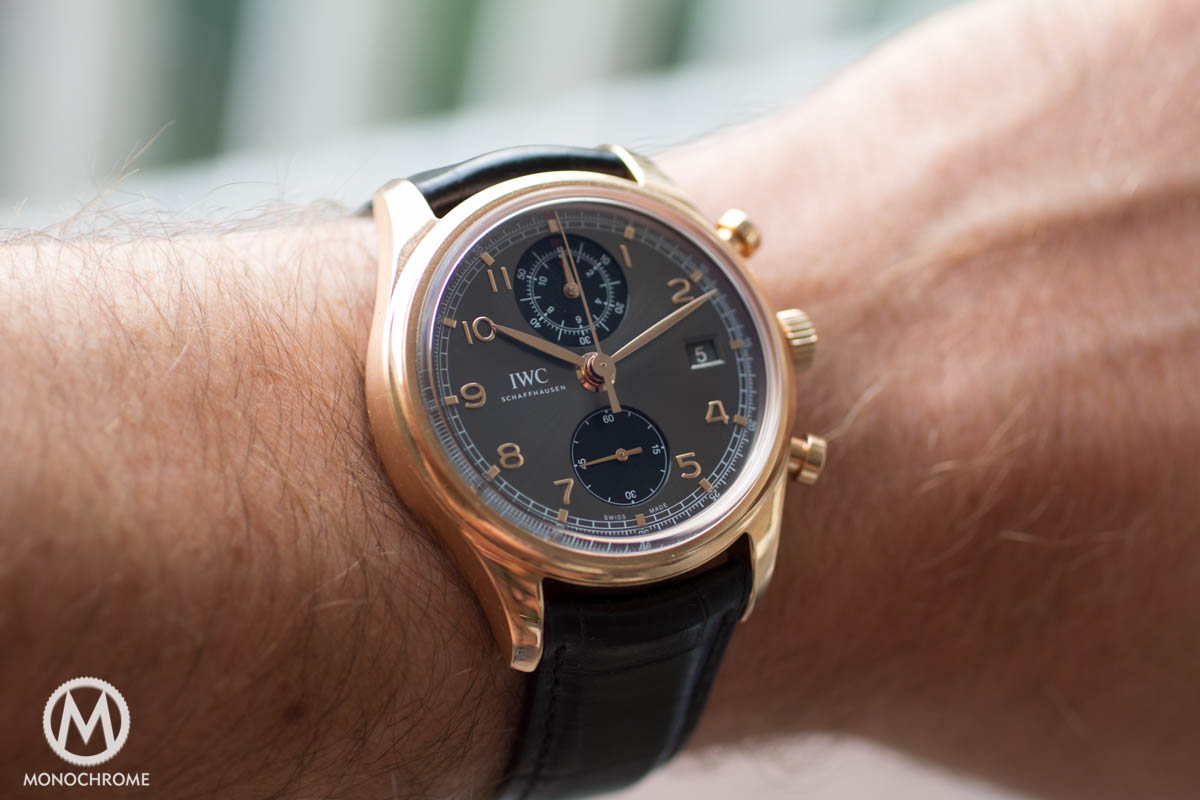
The IWC Portuguese Chronograph Classic looks great, wears great, is very legible and its looks do justice to the word “classic” in the name. What we see on the wrist is not a sporty chronograph, but a chronograph with classic styling. It’s case is slightly ‘chubby’ but also very comfortable on the wrist. It attracts a lot of compliments, both from watch connoisseur and from laymen. The styling is simply perfect in every little detail and the finishing of case, dial, strap and buckle is just excellent. And that is something you can see and feel when you wear the watch.
For this review we chose the 18k red gold version with ‘ardoise’ dial (let’s call it anthracite) and black subdials. This is reference IW390405, and there’s also another version in 18k red gold with a silver-plated dial and there are 2 versions in steel.

There’s also a limited edition with a striking blue dial, the Laureus Sport for Good Edition, that we covered the other week (see here).
Features
The IWC Portuguese Chronograph Classic features a fly-back chronograph and a date function. Centrally positioned, together with the hour and minute hand, is the chronograph second hand. The chronograph’s 60-minute and 12-hours totalizer share the same subdial, at the 12 o’clock position. The running seconds are in the sub dial at 6 o’clock and the date is visible at 3 o’clock.
The chronograph pushers are classically placed at the 2 and 4 o’clock positions. The upper pusher is for starting and stopping the chronograph, while the lower pusher can be used for resetting the hands to zero, or for the fly-back function.
What is a fly-back chronograph?
It is actually a very handy addition to a normal chronograph. Any normal chronograph will allow you to measure elapsed time, say from a horse race or for cooking your spaghetti. The fly-back functions adds the possibility to stop, reset the chronograph hands to zero, and start the next measurement of time again, by ONE PUSH OF THE BUTTON.
Like on most conventional chronographs, most fly-back chronographs have two pushers. One to start and stop the chronograph, and one to reset the chronograph hands to zero. With a fly-back chronograph the hand to reset the hands to zero, also allows you to immediately start another time measurement with just one push of that button.
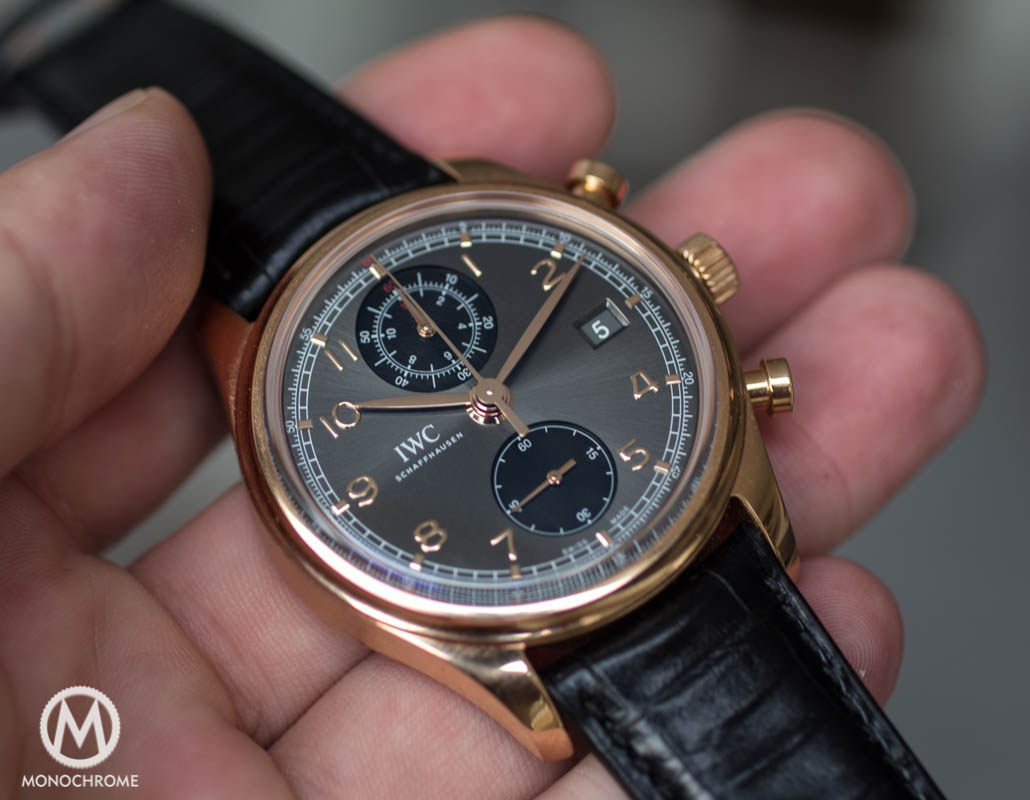
Dial and hands
The anthracite dial goes very well together with the 18k red gold case. This combination was for us the most convincing of the four, but that is due to personal taste. The anthracite dial has two black sub dials, one for the chronograph registers and one for the running seconds, and a railroad minute chapter ring around the dial and another one, broken down to quarter-second hashes.
The applied hour markers are in red gold, to match the case, and so are all five hands and small stick markers next to each applied Arabic number. The running seconds sub dial has a white line around it, with additional white stripes at every five seconds, and Arabic numerals at 15, 30, 45 and 60 seconds. The chronograph sub dial has two hands: one to indicate the elapsed hours and one for the elapsed minutes. A nice little sporty touch, is the red 12 and 60 in the chronograph sub dial, and the red 60 in the most outer chapter ring.
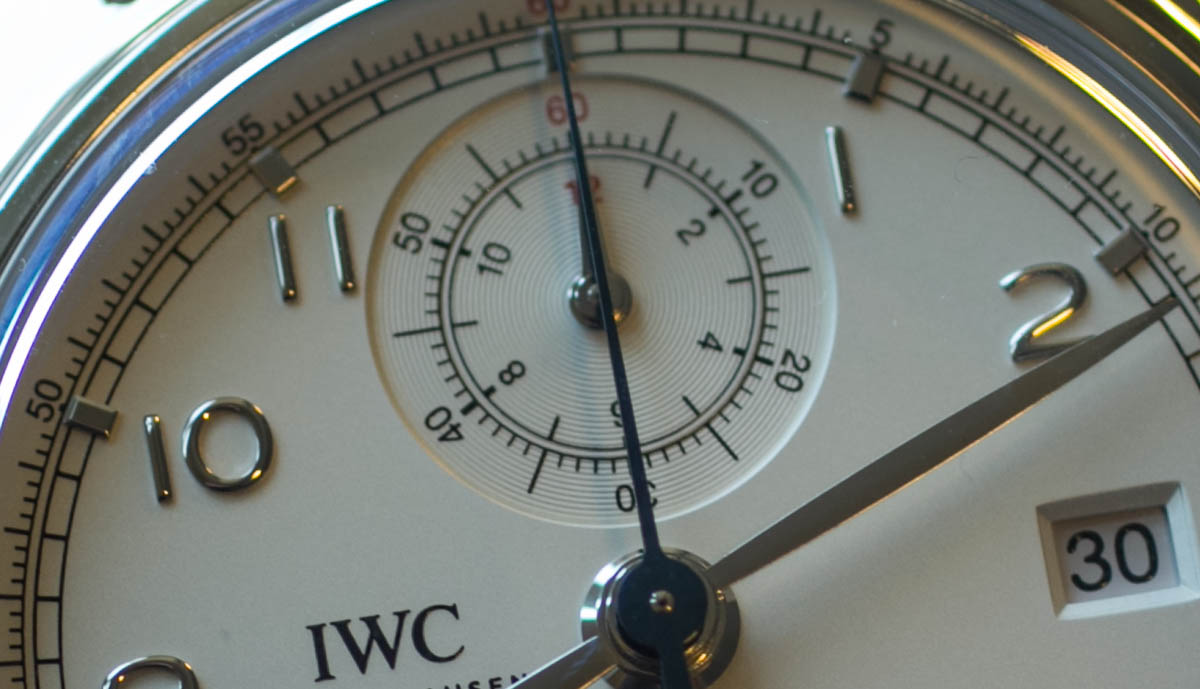
Since these two chronograph hands (in the photo above they are hidden behind the chronograph second hand) are for measuring 60 minutes and 12 hours, they can also be used for a second time zone. That would of course require you to start the chronograph at exactly midnight (or noon) and not accidentally press the chronograph pushers and stop or reset the chronograph hands.
The dial also features an aperture for the date, revealing a date disk in a matching color of the dial. The date is printed either in white on the anthracite date disk or in black on the white date disk. On the watch we reviewed, the date was printed slightly off center, but we need to emphasize that this was a pre-production (prototype) model.
Case and strap
In this section we simply do have to compare the new and old… When the Portuguese Chronograph Classic was announced I actually worried that it would wear much bigger than its older brother (the ref. 3714). This ‘fear’ came from the slightly larger case (42mm of the new ref. 3904 versus 40.9 mm of the older ref. 3714) and the “chubbier” shapes. Although the new IWC Portuguese Chronograph Classic is just 1.1 mm larger, it does indeed wear a bit larger, but hardly noticeable. The difference is actually mainly visible. Let me explain…
The ref. 3714 has a very large, open and clean dial, with a slightly raised outer rim that enhances that “large, open and clean” feeling. On the new ref. 3904 the dial looks smaller because of a thicker bezel around the crystal. That makes the dial (visually) smaller. Another factor that makes the dial look smaller, are the railroad chapter ring and the seconds ring. Although both dials are relatively uncluttered, the older ref. 3714 has the ‘cleanest’ look and therefore the entire watch looks larger than it actually is.
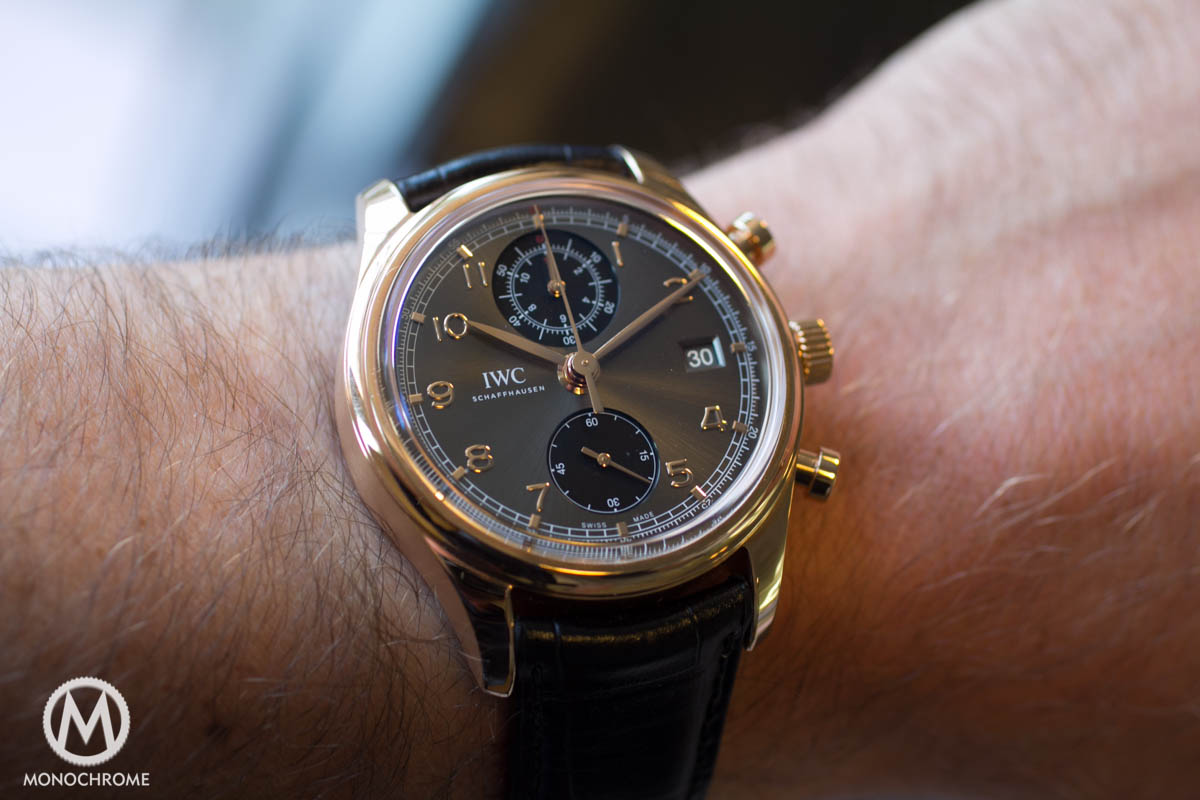
Now the tricky thing about the new ref. 3904, is that this ‘large, open and clean’ look has become somewhat of a trademark of the Portuguese collection. With the new ref. 3904 and also the new Portuguese Hand-Wound 8-Days (we’ll discuss that soon) that trademark look is not going to be prolonged. Yet both new references in the Portuguese collection look absolutely fabulous.
The crystal is a so-called boxed crystal, with arched edges and anti-reflective coating on both sides. That boxed crystal makes the ref. 3904 extra thick (a bit of a draw-back) while it also adds to the classic feeling, because it somehow resembles the old plexi-glass crystal from yesteryear.
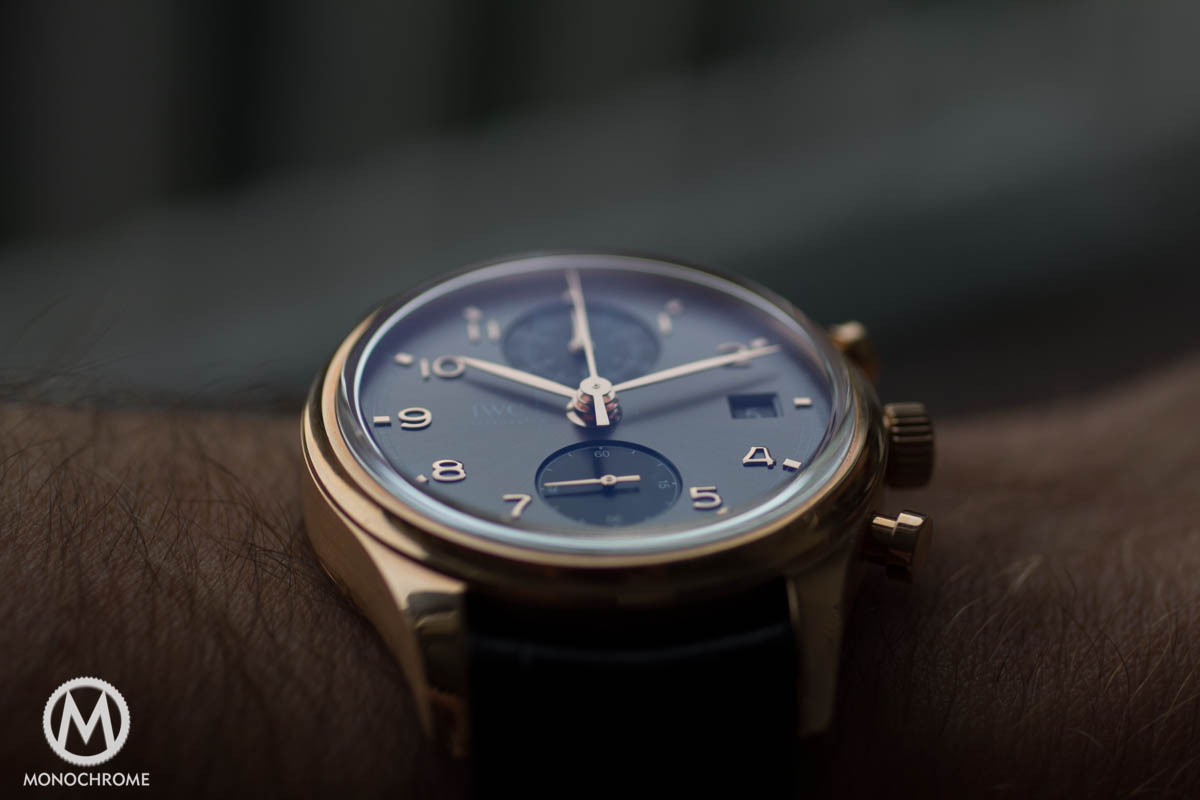
The strap deserves some extra attention, as it is a hand-made strap by Santoni (see here and here). This is the ‘normal’ black alligator leather strap, not the ‘aged’ brown, but the finish is really superb. I would not immediately say that it’s the best strap I have ever had in my hands (or on my wrist), but it does hold up among the best.
Movement
Also in this section we have to compare old and new. The reason is that the new has been equipped with IWC’s in-house movement, calibre 89361; a movement that is also used in the IWC Portuguese Yacht Club and the Ingenieur Chronograph Racer. It features a highly efficient double-pawl winding system that builds up a power reserve of 68 hours in no time.

The entire movement has a nice finish, with circular Côte de Genève on the bridges and rotor. It lacks a real high-end finish, but with a starting price of € 12,000 Euro (including taxes) that would simply be asking too much. All together this movement, calibre 89361, is a very nicely decorated movement that runs perfectly within COSC standards.
Pros and cons
Before we start with the pro and con, we’ll show you a few specifications of both the old ref. 3714 and the new IWC Portuguese Chronograph Classic ref. 3904.

Honestly, before the review I wasn’t to sure I would like the IWC Portuguese Chronograph Classic. After wearing it for some 4 weeks, I can say that I do like it. In fact, I like it a lot. And all I had to do, was not compare it with it’s older sibling any more. When you look at the Portuguese Chronograph Classic on its own merits, instead of as a potential replacement of the older ref. 3714, it holds up more than fine. It is a very nicely designed, very well executed, and finished, timepiece.
Pros
- Beautiful design (case, dial, hands)
- Classic looks that could become a classic when IWC does not redesign it in five years
- Nice in-house movement
- Great functionality: fly-back chronograph, date, double register sub dial for chronograph
- Very nicely finishes (case, movement, Santoni strap, everything)
Cons
- It’s quite pricy with a starting price of € 12,000 Euros (including tax) for the steel versions
- Not immediately recognizable as a Portuguese, however it has all the ingredients of a future classic
- The case is too thick to fit under your cuffs
Some specifications – IWC Portuguese Chronograph Classic ref. 3904
- Movement: calibre 89361, automatic, 68h power reserve, 28,800 vph (4Hz), small seconds, date, fly-back chronograph
- Case: 42 × 14.5mm, steel or 18k red gold, boxed sapphire crystal with anti-reflective coating on both sides, sapphire case back, water resistant to 30 meters (3 bar)
- Strap: Santoni alligator strap with tang buckle, folding buckle for the steel version
More info: www.iwc.com








